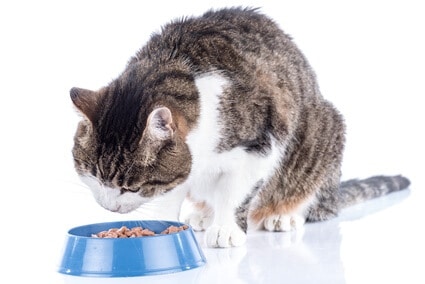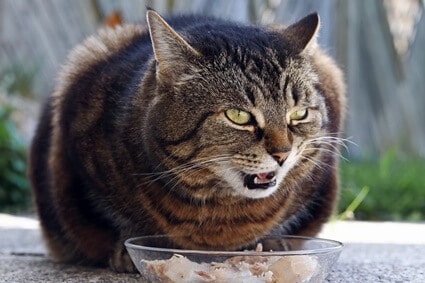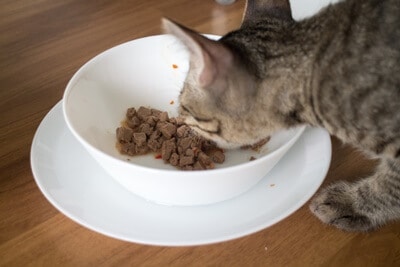Older cats find it harder to digest protein. However, that’s not to say that protein is bad for old cats. It’s a common misconception that all senior cats should be placed on a low-protein diet.
Aging cats need as much protein as younger cats, but the protein must be high-quality and easily digestible. However, cats with kidney disease should consume less protein.
You might think that there’s not much difference between a mature cat and a senior cat. However, research suggests that cats have different nutritional requirements at these two different life stages.
How Much Protein Does a Senior Cat Need Per Day?
You should always check the label on your pet food to ensure your cat is getting enough protein in its diet.
According to the National Academies, a healthy cat that weighs 9 lbs and consumes 250 calories per day should eat 12.5g of protein per day.
Old cats sometimes struggle to digest the protein in cheap, commercial cat foods. That’s why it was thought that senior cats have low protein requirements.
However, this is inaccurate. Senior cats require foods that contain high-quality, single-source forms of protein (muscle meat or organ meat).
Can Senior Cats Eat Too Much Protein?
If your cat has kidney disease, it may become ill on a diet that’s high in protein or a diet based on poor-quality protein.
So, a cat with kidney disease can consume more protein than its body can handle. However, if your senior cat doesn’t have any diseases, it’s unlikely that a meal could contain too much protein.
However, if the meal contains too much low-quality or indigestible protein, your cat may struggle to digest it.
Inferior forms of protein include:
- Meat meal (rendered animal parts)
- Corn
- Meat by-products
When choosing cat food for your senior cat, you should avoid the above ingredients, especially if they appear at the top of the ingredients list.
What Is the Best Food for Senior Cats?
When choosing pet food for your senior cat, consider the following nutritional guidelines:
- Older cats (11 years+) usually require calorie-dense foods.
- Look for foods that contain 30-40% quality, digestible protein (dry matter basis), as long as your cat has no chronic diseases.
- Good senior cat food will have added vitamins and essential fatty acids (EFAs) to support your cat’s digestive system and health.
- Canned/wet food is recommended for senior cats, perhaps with small amounts of kibble.
- Smell and palatability are important because older cats can sometimes lose their appetite.
- Senior cats should be fed small, regular portions to aid digestion.
- If your cat has an age-related illness, then it may require a medically-formulated cat food.
Calorie Requirements
Most vets agree that senior cats (11+) need just as many calories as younger cats, and sometimes more.
If your cat is starting to look scrawny, you should look for pet food that’s higher in calories and encourage them to eat more regularly. Assuming your cat is currently a healthy weight for its body type/breed, you should feed it the following number of calories per day:
| Weight | Size | Number of Calories |
|---|---|---|
| 5 lbs | Small, lean breeds | 170 kcals |
| 10 lbs | Medium-sized breeds | 280 Kcals |
| 15 lbs | Large breeds | 360 Kcals |
The National Research Council provides these guidelines. If your cat is already underweight or overweight based on breed, its daily caloric requirements may differ.
Key Ingredients
There are specially formulated cat foods for senior cats. But what’s so special about senior cat food? If you pick a good-quality, reputable brand, the cat food will have many (if not all) of the following characteristics:
- 30-40% (dry basis adjusted) digestible protein from whole, single sources. Look for cat foods that contain muscle meat or organ meat at the top of the ingredients list. Seek out ingredients like chicken, pig’s heart, or fresh liver.
- Added vitamin E (tocopherol) and vitamin C to promote kidney functioning.
- Added omega 3 fatty acids because cats struggle to absorb fats as they get older.
- Prebiotics/probiotics to support digestion.
- Easily digestible starches (corn, pea, sorghum).
- Fiber to promote digestion (i.e., beet pulp).
- Calorie-dense compared to adult or mature cat food.
- It may contain lower levels of sodium and phosphorous.

Does Wet or Dry Cat Food Have More Protein?
Most vets recommend a mainly wet food diet when feeding senior cats, perhaps with small amounts of added kibble.
Healthy, aging cats should eat a product that’s 30-40% protein (dry basis). Wet food appears to be low in protein because, according to the label, it has around 10% crude protein. This is because it contains a lot of moisture.
You can get a rough estimate of the dry basis equivalent by multiplying the protein content by 4. So, wet food with 10% crude protein contains about 40% on a dry feed basis.
If you compare your wet and dry cat foods, you’ll see that wet food contains higher amounts of higher-quality protein.
Health Conditions and Protein for Older Cats
Cats with the following diseases require a medically-formulated pet food:
- Colitis (inflammation/infection of the colon)
- Chronic Kidney Disease/Failure
- Heart Disease
- Tooth Problems
- Cancer
- Food allergies
- Irritable Bowel Disease (IBD)
If your cat is diagnosed with one of these conditions, your vet will likely recommend a specialist diet.

Kidney Disease and Protein
Kidney disease is among the most common chronic diseases in elderly cats.
Persian cats are most likely to have this condition, but it can affect any cat breed. If your cat has kidney problems, it will need less protein.
When a healthy cat eats protein, its kidneys filter out the waste products from the protein, and these waste products are expelled in the cat’s urine. Cats with kidney problems cannot perform this function efficiently, so they get a build-up of toxic waste products in their blood.
But this doesn’t mean protein should be eliminated from their diet completely because cats need some protein to survive. Instead, it must be fed pet food specifically formulated for cats with kidney disease.
These cat foods are similar to senior cat foods, but there are differences:
- Less Protein – These cat foods contain around 20–30% protein (dry feed basis). The protein is high-quality to reduce the burden on the kidneys. Rabbit or plant-based isolates are the primary protein sources used.
- Low Levels of Sodium – At less than 0.4%, these specialists cat foods contain even less sodium than senior pet foods. This is to prevent dehydration.
- Low Levels of Phosphorus – Phosphorus speeds up the development of kidney disease, so this cat food contains low levels (less than 0.6%) of phosphorus. Rabbit meat is low in phosphorus, so it is used in this type of cat food.
If you put your cat on a specialized diet, you’ll likely be able to slow down the development of chronic kidney disease. The amount of protein a senior cat needs depends on its size and health.
Always feed your cat quality proteins that are easily digestible.

